Voltar
DIURNAL VARIATION IN FISH TANKS WITH TWO DIFFERENT
AERATION SYSTEMS AND ONE CONTROL TANK
Lúcia Helena Sipaúba-Tavares1,
Maria Luiza R. de Souza2 & Sérgio do Nascimento
Kronka3
1Centro de Aqüicultura - Universidade
Estadual Paulista - Jaboticabal - SP - Brasil
2Departamento de Zootecnia - UEM - Maringá
- PR - PG em Aquicultura - UNESP/CAUNESP - Brasil
3Departamento de Ciências Exatas -
Universidade Estadual Paulista - Jaboticabal - SP - Brasil
1Mailing address: Centro de Aqüicultura
- UNESP, Via de Acesso Prof. Paulo Donato Castellane km
05, CEP 14870-000, Jaboticabal, SP, Brasil.
--------------------------------------------------------------------------------
ABSTRACT
Two different kinds of aeration systems
were used during 24 hours (diurnal variation) to evaluate
the effect an aeration system could have on the quality
of water in fish tanks with a continual water flow. An air
diffuser and a water fountain were used and compared to
a control tank (without artificial aeration). There were
no significant differences in the variables studied (P>0.05)
between the control tank and that with an air diffuser,
with chlorophyll a, temperature and total CO2 as exceptions.
The tank with the water fountain was significantly different
(P<0.05) from the other two tanks for all variables except
pH, that had similar values for the three tanks. Temperature
and total CO2 values did not show significant differences
(P>0.05) for the tank with an air diffuser. When comparing
samples collected from the surface and the bottom of the
tanks, no significant differences (P>0.05) were apparent
regarding the limnological parameters analysed.
Key-words: Aeration systems, fish tanks,
limnological parameters, diurnal variation
--------------------------------------------------------------------------------
INTRODUCTION
With the continual increase of world production,
artificial mechanisms are used in an attempt to gain greater
productivity in restricted space areas.
The water quality in shallow artificial
cultivation systems can be maintained with a continual flow
of water or an increase in oxygen concentration. This can
be obtained with artificial aeration systems (4).
The main purpose of continual flow is to
carry away the excess organic material deposited at the
bottom of the tanks, consequently decreasing the decomposition
processes that consume oxygen. A build up of organic material
leads to an accumulation of ammonia and nitrite in concentrations
that are toxic to fish (11).
Artificial aeration systems provide greater
oxygen availability, besides reducing manganese and iron
concentrations which are insoluble in oxygenated water.
Aeration disrupts thermal stratification permitting greater
productivity of the system (18).
According to Thomforde and Boyd (14), continuous
aeration can help reduce metabolites in the water, increasing
the diffusion to the atmosphere of ammonia, carbon dioxide
and other dissolved gases by way of the air/water interface.
However, continuous mechanical aeration maintains high concentrations
of suspended solids, reducing water transparency and decreasing
primary production in the tank.
There is little information on the effect
of mechanical aeration in aquaculture. According to Thomforde
and Boyd (14), systems that discharge great volumes of air
under high pressure are the best for fish cultivation; however,
continual use leads to an increase of nitrogenous compounds
when compared to those used only in emergency periods.
There are currently several types of aerators
on the market. In this study a water fountain system was
used, which promotes vertical and horizontal water movement.
The other system used was an air diffuser placed at the
bottom of the tank, creating a bubble stream throughout
the water column.
The objective of this study was to evaluate
the effect, on limnological parameters, of two different
aeration systems (with an air diffuser and a water fountain
system) in fish tanks with a continual water flow, comparing
them to a tank without artificial aeration (control). Water
samples were collected over a 24 hour period, although the
tanks were only aerated at night.
MATERIAL AND METHODS
This experiment was conducted at the Aquaculture
Center of UNESP, situated at 21o15’22" S and
48o15’58" W, at a height of 595 meters and 5
km from the nearest urban perimeter. Three tanks were used,
each with 4.5 m by 8.5 m and 1.0 m in depth, with a continual
water flow. One tank had no artificial aeration being the
control (A1), while the other two had artificial aeration
systems (A2 and A3). For the aeration of tank A2 an air
diffuser was used, consisting of a 2 HP motor that aspirated
atmospheric air that was distributed in the water column
as bubbles from the bottom to the surface. The other system
used was a water fountain (A3), consisting of a pump with
a 0.5 HP motor that could suck the water at 60 cm of depth
and direct it to one of the sides of the tank. There, two
PVC tubes (3/4) that were approximately one meter high and
that had air diffusers on the ends, sprayed water into the
tanks like a fountain (Fig. 1). The aeration systems were
kept working from 12:00 p.m. to 06:00 a.m..
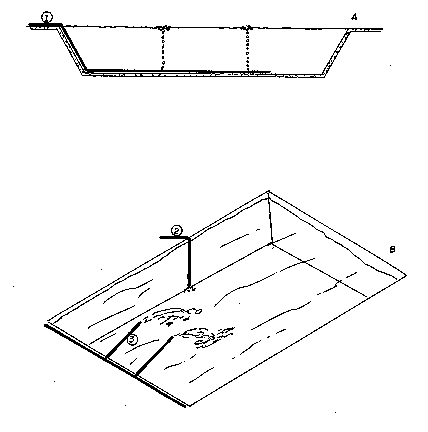
Figure 1. Schematic of the aeration systems
used in this study where: A= air diffuser and B= water fountain
(1- PVC tube with air diffuser; 2-PVC tube for water suction;
3-PVC tubes (3/4) for water outlet).
Water samples were taken at 3 hour intervals,
using a Van Dorn bottle with a 5 liter capacity, always
at the same place in the tank but at two different depths:
surface (0.20 m) and bottom (1.10 m). Water samples were
taken from the source, water from a well located near the
tanks.
The following limnological variables were
analysed:
- temperature: determined with a digital
Corning PS 16 thermometer;
- pH: obtained using a digital Corning PS
15 pH meter;
- conductivity: determined with a digital
Corning PS 17 conductivity meter;
- dissolved oxygen: determined by the Winkler
method (3);
- alkalinity: determined according to Golterman
et al. (3);
- inorganic forms of carbon: calculated
according to Mackereth et al. (7);
- dissolved nutrients: nitrite, nitrate,
orthophosphate and total phosphorus analyses were made according
to Golterman et al. (3), and the ammonia analysis according
to Koroleff (6);
- chlorophyll a: determined according to
the technique described in Nush (10), using hot ethanol
as the solvent.
The data obtained was submitted to a variance
analysis and mean values were compared using the Tukey test,
with a 5% probability level.
RESULTS AND DISCUSSION
The use of mechanical aeration has avoided
sudden falls in dissolved oxygen concentrations, where oxygen
levels fall below 2 mg/L during night periods. In the mornings
the systems are turned off when phytoplankton are able to
restart photosynthesis. This way fish stress is reduced
(14).
The dissolved oxygen values in the tanks
studied were mainly above 4 mg/L (Fig. 2), except the tank
that had the water fountain aeration system (A3) which did
not show significant differences (P>0.05) between the
different depths (Table 1).
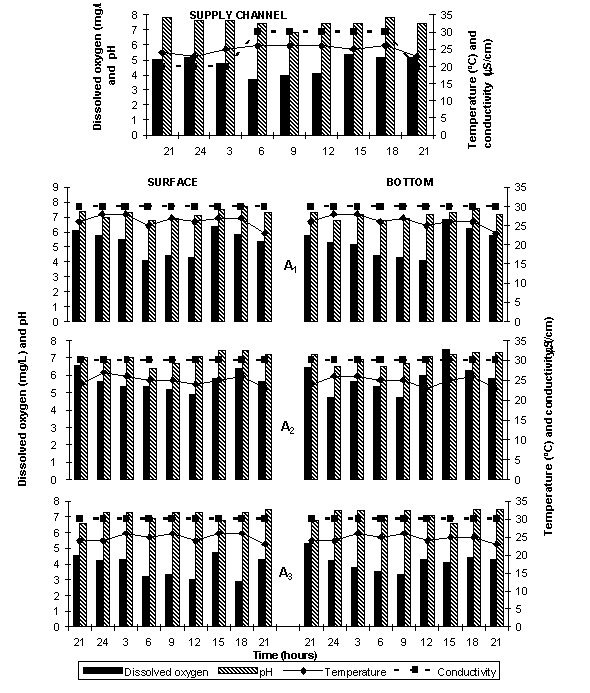
Figure 2. Dissolved oxygen, pH, temperature
and conductivity fluctuations in three fish tanks, with
different aeration systems (A1 = control - no artificial
aeration; A2 = air diffuser; A3 = water fountain) and in
the supply channel, for a period of 24 hours.
Table 1. Mean and F test values, variation
coefficient and Tukey test results for aeration systems
and depths.
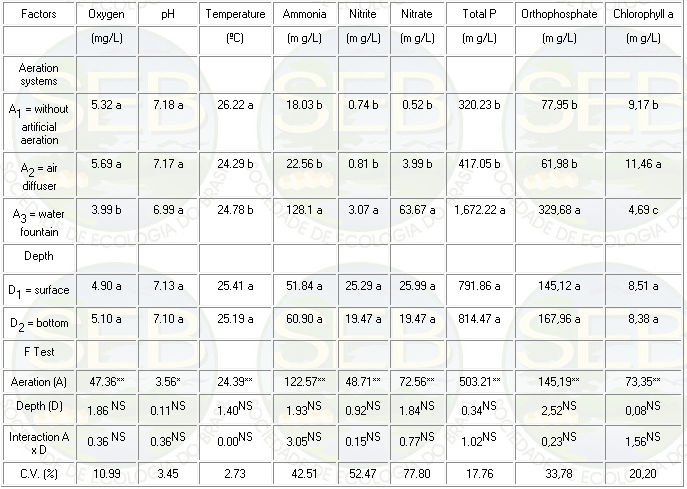
In each column, for each factor, mean values
followed by the same letter do not differ between themselves
according to the Tukey test (P>0.05).
**- significant (P<0.01) * - significant
(P<0.05) NS - not significant (P>0.05)
Fluctuations in dissolved oxygen values
are more pronounced in shallow systems by the influence
of continual water
flow, residence time of the water and biological
processes, increasing this variable and removing carbon
and hydrogen sulfite with iron precipitation (8).
The water source and the channel leading
from it affected the water quality. At this stage, various
nutrients were already present in the water and the channel
turbulence provided a certain degree of aeration (Fig. 2).
In shallow systems the biological processes are much more
pronounced and photosynthesis becomes the main factor responsible
for variations in oxygen levels.
No significant differences were observed
(P>0.05) when comparing the oxygen levels in tanks A1
(without aeration) and A2 (air diffuser) with mean values
of 5.32 and 5,69 mg/L respectively, both differing from
A3 (water fountain) with a mean value of 3.99 mg/L (Table
1).
No significant differences (P>0.05) were
observed between the two depths analysed, surface and bottom,
for any of the limnological parameters analysed in this
study (Tables 1 and 2).
Table 2. Mean and F test values, variation
coefficient and Tukey test results, for aeration systems
and depths.
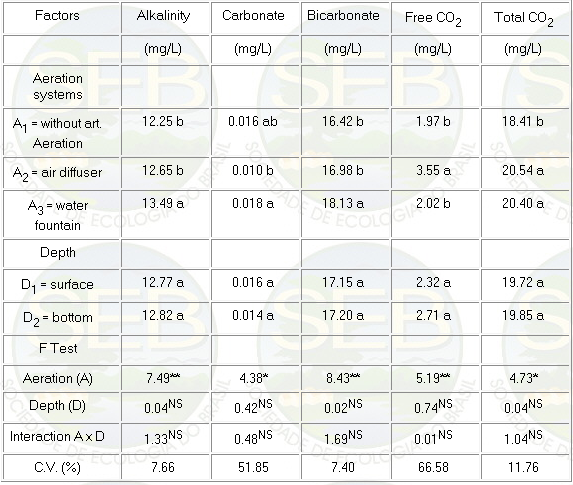
In each column, for each factor, mean values
followed by the same letter do not differ between themselves
by the Tukey test (P>0.05).
** - significant (P<0.01) * - significant
(P<0.05) NS - not significant (P>0.05)
In experiments performed by Sipaúba-Tavares
et al. (11), two depths of 30 and 60 cm were compared and
no significant differences in limnological values were evident.
The aforesaid experiment compared two tanks, one stocked
with tilapia fish and the other with a variety of fish although
no difference was observed between the different depths,
differences were observed between the two tanks, which the
authors reasoned was due to management, hydraulic residence
time, and the feeding behavior of the cultivated species.
Some authors (9,13) have observed that,
in shallow systems, climatic factors have a direct influence
on water temperature.
The temperature in the tanks studied showed
a slight decrease at night, tending to increase during the
day. With aeration, there tends to be less stratification
of temperature within the water column and thus nigh time
temperatures only decreased slightly (Fig. 1). The tanks
were of small dimensions and had a continual flow of water
leaving through the bottom. This allowed a greater liberation
of hypolimnetic water that could interfere with the environment
and decreased the tanks temperature, especially at nigh
time when a greater cooling of the water occurs.
The conductivity of water did not show any
variation between the tanks, showing constant concentrations
throughout the study of about 30 m .S./cm. The water source
also had a direct influence on conductivity, as it presented
similar or equal concentrations to the tanks (Fig. 2).
Thomforde and Boyd (14) observed that aerated
tanks present higher conductivity concentrations when compared
to those without artificial aeration.
The pH of water varied from slightly acid
to alkaline, without significant differences (P>0.05)
between the tanks (Table 1).
There is a close relationship between carbonate
levels and environmental pH and these are inversely proportional
to the bicarbonate and calcium levels in the water (15).
Bicarbonate was the dominant form of inorganic
carbon, showing an inverse relationship with the pH in the
tanks studied (Figs. 2 and 3).
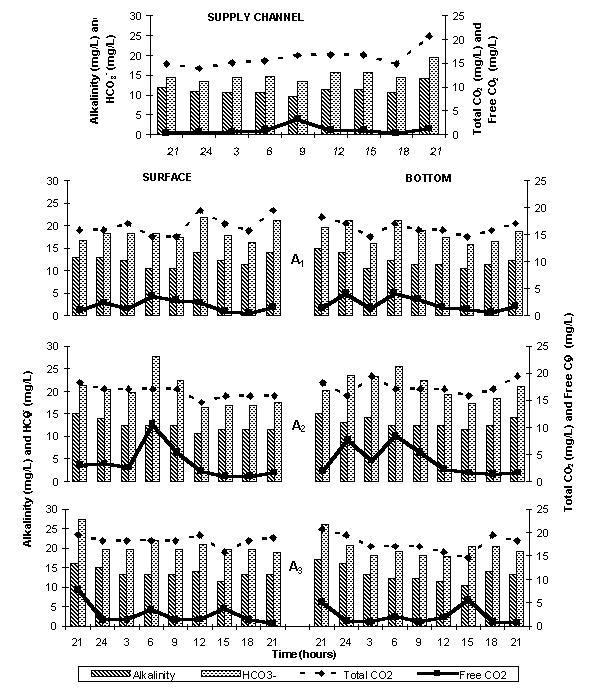
Figure 3. Alkalinity, bicarbonate, free
CO2 and total CO2 fluctuations in three fish tanks, with
different aeration systems (A1 = control - no artificial
aeration; A2 = air diffuser; A3 = water fountain) and in
the supply channel, for a period of 24 hours.
The forms of inorganic carbon in both of
the aeration systems were significantly different (P<0.05);
however, the tank with no artificial aeration and the one
with the air diffuser did not show significant differences
(P>0.05). Regarding total CO2, the tanks that had artificial
aeration systems showed similar (P>0.05) results, both
significantly superior to the control tank (P<0.05) and
free CO2 never exceeded 4 mg/L of CaCO3; meanwhile, carbonate
concentrations showed negligible values in the environment
(Table 2).
Alkalinity concentrations were similar in
behavior to the forms of inorganic carbon, without significant
differences between A1 and A2 (P>0.05). However there
were significant differences when compared to A3 (P<0.05)
(Table 2). Alkalinity and inorganic carbon, were influenced
by the water source that showed concentrations very close
to those of the tanks (Fig. 3).
Environments that have a dominance of bicarbonate
have a tendency to affect alkalinity concentrations since
it can work as a base or an acid (1). On the other hand,
alkalinity is directly related to the decomposition of organic
material and, consequently, produces great quantities of
CO2 leading to an increase in CaCO3.
Sediment acts as a link or source of ammonia,
nitrite and nitrate for the water column; however, the concentrations
of these three elements decrease with time because of their
fast assimilation by algae (2). Of the nitrogenous compounds,
ammonia was dominant in the system since its concentration
in cultivation tanks is
associated mainly to fish excretion, alimentary
residues, decomposition of organic material, nitrification
and denitrification processes, sediments and others (Fig.
4).
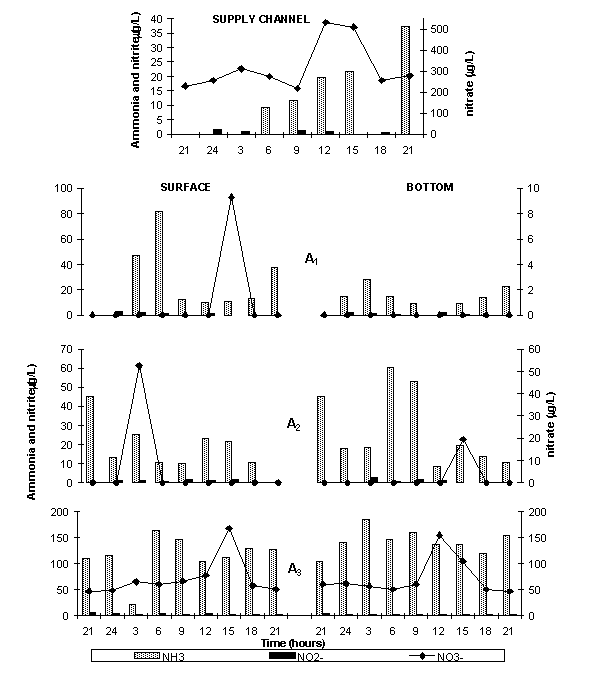
Figure 4. Ammonia, nitrite and nitrate fluctuations
in three fish tanks, with different aeration systems (A1=
control - no artificial aeration; A2 = air diffuser; A3
= water fountain) and in the supply channel, for a period
of 24 hours.
The concentrations of ammonia in the tanks
studied were higher in A3, showing significant differences
(P<0.05) for A1 and A2, the same occurring for nitrate
and nitrite (Table 1).
In systems that receive great quantities
of nutrients, nitrate is the final product of the nitrification
process, becoming the major source of inorganic nitrogen
in the environment (16). Besides, nitrate is highly mobile
in soil that suffers as an influence of sediment mixture
and suspension (17).
Low concentrations of nitrite, or even its
absence in the environment, can be associated to the incomplete
oxidation of ammonia or its quick use by the phytoplanktonic
community (Fig. 4).
An inverse relationship between phosphorus
and chlorophyll a was evident, indicating the assimilation
of this component by the algae biomass that has the ability
to stock this element. Algae has an ample capacity to assimilate
organic substrates, showing a competitive advantage when
compared to obligatory photoautotrophs organisms (5,12).
Tank A3 was significantly different (P<0.05)
from A1 and A2 , which did not differ (P>0.05), for total
phosphorus and orthophosphate; while chlorophyll a showed
significant differences when comparing the three tanks (P<0.05),
with higher values for A2, followed by A1 and A3 (Table
1 and Fig. 5).
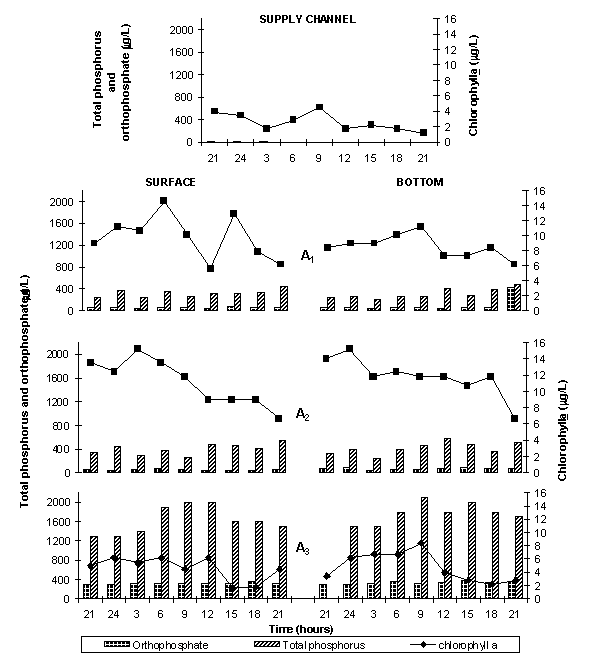
Figure 5. Total phosphorus, orthophosphate
and chlorophyll a fluctuations in three fish tanks, with
different aeration systems (A1= control- no artificial aeration;
A2= air diffuser; A3= water fountain) and in the supply
channel, for a period of 24 hours.
According to the results obtained in this
study, the use of mechanical aeration systems is not necessary
in fish tanks of small dimensions (4.5 by 8.5 m and 1.0
m in depth), since the continual flow of water sustains
adequate conditions for cultivation. However, if the use
of aerators becomes necessary because of a high stock density,
the use of an air diffuser type of aerator is advisable
as it does not cause harsh water movement.
ACKNOWLEDGEMENTS
The authors would like to thank Silvia R.L.
de Laurentiz and Regina Helena Sant’Ana de Faria for
their help in the field and laboratory work.
--------------------------------------------------------------------------------
RESUMO
Variação nictemeral em tanques
de piscicultura com dois sistemas de aeração
e um tanque controle. Com o objetivo de avaliar o efeito
dos sistemas de aeração na qualidade da água
em tanques de piscicultura de fluxo contínuo em um
período de 24 horas, foram utilizados dois tipos
de aeradores, um chafariz e outro compressor radial comparando-os
com o controle (sem aerador). Em relação as
variáveis estudadas, não apresentaram diferenças
significativas (P>0,05) entre o tanque controle e o de
compressor radial, com exceção da clorofila
a, temperatura e CO2 total. O tanque com chafariz diferiu
significativamente (P<0,05) dos outros dois tanques,
com exceção do pH que foi similar entre os
três tanques. Foram também realizadas coletas
entre superfície e fundo, não apresentando
diferenças significativas (P>0,05) entre esses
dois estratos para as variáveis limnológicas
analisadas.
Palavras chave: sistema de aeração,
tanques de piscicultura, parâmetros limnológicos,
variação nictemeral.
--------------------------------------------------------------------------------
REFERENCES
Boyd, C.E. Water quality in ponds for aquaculture.Auburn
University, Alabama. 1990, 482p.
Diab, S. & Shilo, M. Transformation of nitrogen in sediments
of fish ponds in Israel. Bamidgeh, 38 (3): 67-88, 1986.
Golterman, H.L., Clymo, R.S. & Onhstad,
M.A. Methods for physical & chemical analysis of fresh
waters. Blackwell Sci.Publ., London. 1978, 213p.
Hopkins, J.S., Hamilton, R.D., Sandifer,P.A., Browdy, C.L.
& Stockes, A.D. Effect of water exchange rate on production,
water quality, effluent characteristics and nitrogen budgets
of intensive shrimp ponds. J.World Aquac.Soc., 24: 304-320,1993.
Hopkins, J.S., Sandifer, P.A. & Browdy, C.L. Sludge
management in intensive pond culture of shrimp: Effect of
management regime on water quality, sludge characteristics,
nitrogen extinction, and shrimp production. Aquacultural
Engineering, 13: 11-30, 1994.
Koroleff, F. Determination of nutrients. In: Methods of
sea water analysis. GRASSNOF, K (ed.), Verlag Chemie Weinhein:
117-181, Germany. 1976.
Mackereth, F.J.H., Heron, J. & Talling, J.F. Water analysis:
Some revised methods for limnologists. Freshwater Biological
Association Scientific Publication n0 36, Titus Wilson &
Sons Ltda. London, 1978, 121p.
Masser, M., Whitis, G. & Crews, J. Production of crawfish
in Alabama. Agriculture & Natural Resource., 6: 1-18,
1994.
Nogueira, M.G. & Matsumura-Tundisi, T. Limnologia de
um sistema artificial raso (Represa do Monjolinho - São
Carlos, SP) I: Dinâmica das variáveis físicas
e químicas. Rev.Brasil.Biol., 54: 147-159, 1994.
Nush, E.A. Comparison of different methods for chlorophyll
and phaeopigments determination. Archiv fuer Hydrobiologie,
14: 14-36, 1980.
Sipaúba-Tavares, L.H. Limnologia Aplicada à
Aqüicultura. Jaboticabal, FUNEP/UNESP, boletim nº
1, 1995, 72p.
Sipaúba-Tavares, L.H. Variação diurna
de alguns parâmetros limnológicos em três
viveiros de piscicultura submetidos a diferentes tempos
de residência. Acta Limnologica Brasiliensia, 8: 29-36,
1996.
Sipaúba-Tavares, L.H., Gomide, F.B. & Olivera,
A. Dynamic limnological variables studied in two fish ponds.
Brazilian Journal of Ecology, 2: 90-96, 1998.
Thomforde, H.W. & Boyd, C.E. Effects of aeration on
water quality and channel catfish production. Isra.J.Aquac.Bami.,
43: 3-26, 1991.
Thornton, K.W. , Kimmel,B.L. & Payne, F.E. Reservoir
Limnology: Ecological perspectives. John Wiley & Sons,Inc.,
New York, 1990, 246p.
Tucker, C.S. & Boyd, C.E. Water quality. In C. S. Tucker
(ed.), Channel Catfish Culture, Elsevier Science Publishers
B. V., Amsterdam, The Netherlands, 1985.
Wang, W.C. & Evans, R.L. Nutrients and quality in impounded
water. Jour. AWWA., 1: 510-514, 1970.
Wheaton, F.V. Aquaculture Engeneering.Wiley Interscience,
New York, 1977, 178p.

